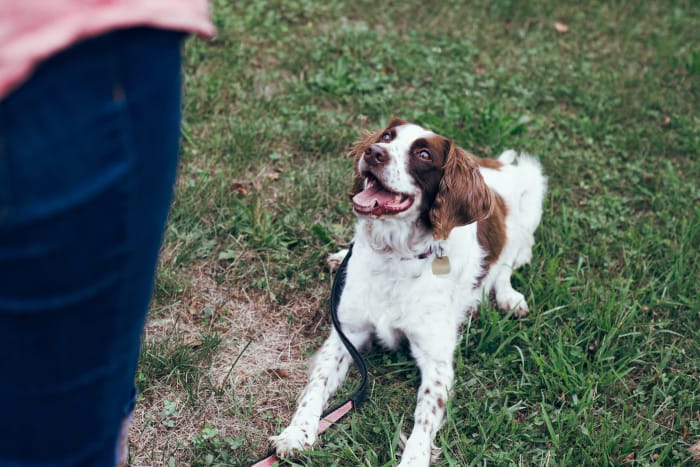Many people ask us about positive reinforcement training and the lack of punishment within this training style. Often they ask, “What if a dog does something wrong? If you don’t punish it, are you not then, in fact, just allowing it to happen? Isn’t it being reinforced by not punishing it? If a dog jumps on someone or does something terrible, like lunges or bites, and you don’t punish that, isn’t the dog just going to get away with it?”
“Doesn’t the dog need to be punished to understand that it’s unacceptable?” And our answer is no, that’s not the way it works.
We don’t punish a dog for not knowing any better.
We don’t punish them for being insecure, scared, or nervous. For making a wrong decision, feeling overexcited and not knowing how to regulate their emotions, or for being impulsive because something was tempting. A lot of people think their dogs know better. They put these human emotions on the dog and say ‘He knows better! He’s just being a pain!’, or, ‘He’s just doing that to piss me off.’ They get angry at their dog – outraged and frustrated… because they think he knows he’s not supposed to.
But I’m going to challenge you there. Your dog definitely does not know better.
If your dog knew better, he wouldn’t do it. Dogs don’t want to be bad. They don’t want to be annoying. They don’t want to make you mad or be a bad dog. Dogs do things because of impulsivity, not knowing how to regulate their emotions, or because they’re feeling insecure, fearful, nervous, or excited.
So if we punish that, does it help them? No, it doesn’t.
Here is another way to think about it: I heard a fantastic child psychologist speak about children in this way once, and I’m going to put it in terms of dog training and behavior.
Imagine your dog didn’t know how to swim, and you wanted your dog to swim. It’s summertime, you’re at a lake, and there’s a dock, so you bring your dog out to the dock. You jump into the water with your dog in your arms, but when you hit the water, your dog panics, floundering, splashing, pawing at you and panicking.
You realize that your dog genuinely does not know how to swim; it’s panicking and will not know how to swim back to the shore. Are you going to punish your dog for not knowing how to swim? For pawing at you? Are you going to get angry at it? Do you give it a consequence for not knowing how to get from point A to point B in the water?
No! You’re going to be compassionate and you’re going to realize your dog is panicking, and you’re going to help it.
Then, you’re going to take a step back and go. ‘Hmm. Okay. Maybe that wasn’t the right thing to do. Maybe I shouldn’t have jumped into the water with my dog. Maybe I need to take a step back and slowly teach my dog that the water is safe.’
You need to teach your dog that you’re trustworthy, that the environment is safe and that you’re not going to put it in that situation again.
Your goal now is to teach your dog to be calm, comfortable, and confident in the water. You’re going to take baby steps to get it there so that it eventually can feel confident and comfortable swimming and also work on building your dogs trust in you as their trusted human.
Now let’s do the same thing with behavior.
Suppose your dog jumps on the counter and steals some food, or jumps on people that visit your home, lunges at people walking past, barks out the window, growls when you take its bone away, steals your socks, whatever it’s doing that you would consider bad behavior. Before you do anything else, I want you to stop and think ‘hey, my dog clearly doesn’t know any better’.
You’re going to say to yourself, and your dog, ‘let’s take some steps back, figure out what you need, and work slowly and diligently to get you to a place where your needs are met, you feel confident, calm and can make good choices.’
Because if you punish your dog for not being able to swim, it’s not going to help them swim better next time.
It’s the same with a behavioral problem. If your dog lunges at someone and you punish it for lunging, then next time, yes it might not lunge, since it could be scared about what you’re going to do to it. However, it doesn’t stop the dog from having that emotional reaction to whatever made it lunge in the first place. The emotion will just be repressed and will come out in other ways, or at another time… and it definitely won’t help your dog to trust you by punishing it.
So instead, help your dog learn that it can control itself. Let’s help it learn to regulate its emotions. Let’s help it learn self confidence, so it does not feel insecure or overexcited, and won’t feel the need to lunge in the first place.
Let’s help your dog learn to trust your guidance and leadership, and let’s change the old fashioned ways of dog training by educating ourselves and showing our dogs that we are trustworthy and understanding. We know better now.



